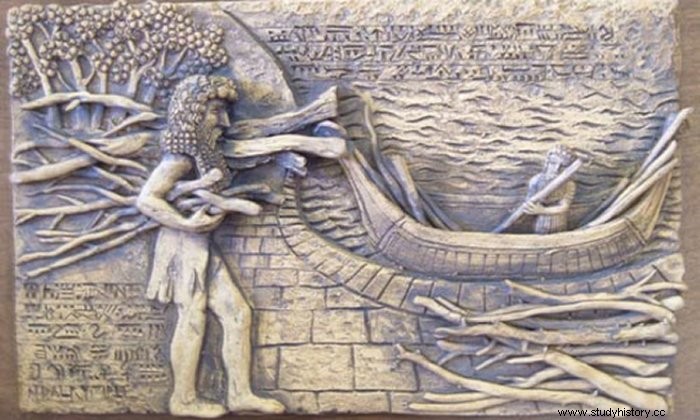What is The Epic of Gilgamesh?

The Epic of Gilgamesh is an ancient Mesopotamian poem, written in Akkadian language in the Mesopotamian city-state of Uruk. It is widely considered to be the oldest piece of epic world literature on earth, before the works of Homer with over 1500 years. The Akkadian text is believed to have been written by a Babylonian scribe named Sin-liqe-unninni between 1300 and 1000 BCE Sin-liqe-unninni probably drew on older Sumerian legends and poems in cuneiform to write the story of Gilgamesh, most of which date back to the early third or late second millennium BCE. Gilgamesh is written on 12 incomplete, fragmented Akkadian tablets, all made at different times and in different places. Unfortunately, much of the text remains lost, and today we have only 3200 of an estimated 3600 lines. However, across the nineteenth and twentieth centuries, scholars localized and deciphered these fragments, combining them to create a 'complete' or somewhat coherent narrative of the original narrative.
Who was Gilgamesh?
The titular hero of The Epic of Gilgamesh probably refers to a true Mesopotamian ruler of the same name. A list of kings indicates that it was actually a ruler of Uruk named Gilgamesh in about 2600 BCE. While little is known about the life of the actual king who inspired the legend, the figure of Gilgamesh is often represented as a great hero in many Sumerian texts. In addition, the historical king was eventually given complete divine status as God. In fact, the aforementioned Sumerian royal list registers his reign as 126 years! Many later Mesopotamian kings would eventually invoke his name and associate his lineage with their own, to elevate their own status. When Shin-leqi-unninni used Sumerian sources to write the epic, Gilgamesh had already been a popular hero for centuries. According to these other legends, his father is said to have been the priest-king Lugalbanda (also mentioned in other Sumerian poems, and written as having magical abilities), and his mother is said to be the goddess Ninsun.

Gilgamesh was thus a demigod who possessed superhuman strength, and apparently lived an unusually long life. He probably makes his first appearance in the Sumerian story Inanna and the Huluppu Tree. In this story, the goddess Inanna plants a tree infested with demonic snakes in the center, and appeals to her family for help in eradicating it. Gilgamesh appears as her loyal brother who comes to her rescue and kills the snake. While this story was written centuries before the epic, such demonstrations of heroism demonstrate Gilgamesh's divine status among Sumerian culture.
The story of Epic of Gilgamesh
In addition to the interesting history of Gilgamesh himself, the discovery of the original Akkadian tablets has a broader cultural significance both in the Western world and its place of origin. In 1849, the Akkadian version of Gilgamesh was unveiled by the library in the 7th century BCE of the Assyrian king, Ashurbanipal, in Nineveh, the capital of the ancient Assyrian Empire (located in present-day Iraq). This discovery was made by a European archaeologist named Austin Henry Layard.
Layard's discovery was part of a broader XNUMX century initiative on behalf of European institutions and governments to fund expeditions to Mesopotamia, in the hope of finding physical evidence that would confirm events described in the Bible. During the mid-nineteenth century, many people in the Western world began to question the historical truth of the Bible. Advances in several scientific fields (such as geology, archeology and paleontology) have evidence that the earth was much older than some had thought, and that human societies had existed long before the dates assigned to the flood. As a result, many scientists and scholars doubled their efforts to find evidence of Bible truth through these expeditions.
The discovery of these Akkadian tablets did not initially give the Western world the security it sought, as only the existence of Gilgamesh disproved the belief that the Bible was the oldest book in the world. However, all that changed a few years later, following the findings of a scholar named George Smith. In 1861, Smith, a self-made scholar with an acute interest in ancient Mesopotamian texts, was hired by the British Museum to decipher cuneiform tablets that had been found years before in Nineveh. After deciphering several of the Akkadian tablets that make up the Gilgamesh epic, Smith found a segment on one of the tablets that describes a major flood. The accounts of this flood suggest similarities with the story of Noah from the Bible book of Exodus, which is in the eleventh part of the XNUMX. the board. However, this flood seemed to have occurred much earlier than the Bible claimed, so the timelines had to be adjusted.

Smith was later approved for another expedition to Nineveh to find more fragmented tablets of the epic- his early translations of the tablets were eventually published in the 1870s, under the title The Chaldean Account of Genesis. These findings challenged literary and biblical science, forcing Western scholars to reevaluate ancient history in a turbulent time of imperial conflict.
Early plot by Gilgamesh
In the same way as his divine status mentioned in earlier Sumerian texts, the Gilgamesh epic begins with an introduction to Gilgamesh, as an epic hero and protagonist. He is a demigod blessed with strength and physical beauty, and is also king of Uruk, the strongest and greatest king in a glorious kingdom. Gilgamesh's adventures begin when complaints arise about his abuse of power as king of Uruk. As a result, Aruru, the goddess of creation, creates a rival for Gilgamesh named Enkidu. Enkidu lives among other animals, and Gilgamesh eventually sends a prostitute to seduce and tame him. After being seduced, Enkidu loses his 'wild' behavior and learns human ways. He finally decides to come and live in Uruk.
When he arrives in Uruk, Enkidu and Gilgamesh meet in the city and fight. After a powerful fight, Gilgamesh defeats Enkidu, but decides to save his life. Gilgamesh accepts Enkidu's advice on learning human values, such as mercy and nobility. Both men are transformed through their developing friendship, and learn many lessons from each other. Gilgamesh and Enkidu embark on several adventures together, such as when Gilgamesh proposes to travel to the sacred Cedar Forest, to kill guardian demon Humbaba. A big fight ensues when Enkidu and Gilgamesh confront Humbaba, but Gilgamesh eventually kills him. They cut down a huge cedar tree and use it to make a massive door for the gods.

Later, the goddess of love and war, Ishtar, makes sexual advances against Gilgamesh, which he denies. Ishtar is angry at the rejection and sends a "bull of heaven", bringing drought and disease to Uruk in return. Gilgamesh and Enkidu manage to kill the bull, but as a result, Enkidu is punished by the gods. As a result, he becomes seriously ill and eventually dies. Destroyed by Enkidu's death, Gilgamesh refuses to leave the body for several days and is determined to avoid the same fate. He becomes obsessed with achieving immortality, and takes a journey to visit a man named Utnapishtim. Utnapishtim and his wife are the only known people who have survived the "great flood" that happened years before. They are also believed to have been given immortality by the gods. Gilgamesh travels far east, to the twin peaks of Mount Mashy at the 'ends of the earth', to find these survivors in a heaven-like place.
Utnapishtim and the 'Great Flood'
When he reaches their location on the island of Dilmun, Utnapishtim reprimands Gigamesh for trying to seek immortality. He reminds him that human destiny is inevitable, and trying to change such a destiny destroys the joy of life. Utnapishtim then remembers his own experiences. He tells how a great flood was brought into the world by a god who wanted to punish mankind for the confusion and changes they brought to earth. Utnapishtim was warned by the other gods to build a ship on standby and load it with all his family and belongings. When the flood finally came as promised, everything was killed except him and everyone on board his ship. This part of the epic, mentioned on the twelfth tablet, was the most significant part for European scholars who studied the Akkadian tablets in the nineteenth century, as it proved the existence of a great flood similar to events described in the Bible.

Utnapishtim suggests to Gilgamesh that if he can stay away for seven days in a row, then the gods can give him immortality. However, due to his exhausting journey, Gilgamesh fails this test and is unable to escape the prospect of his own death. Utnapishtim instructs Gilgamesh to find a plant that renews youth to lift his spirits, which he finds successful and plans to eat when he returns home. He then decides to return to Uruk, but while stopping at a pool, a snake steals the precious plant, destroying Gilamesh's hopes of regaining his youth. He mourns the loss, but is reminded of his prosperous homeland when he returns to Uruk.
Simultaneous relevance of Gilgamesh
Despite its age, the Gilgamesh epic continues to inspire many manifestations of literature, art, music and popular culture around the world. These manifestations began mainly in the early twentieth century, when reliable translations of the epic were made more accessible to the public; this eventually allowed the story to reach a variety of audiences and genres. Especially themes of existentialism in the epic held the interest of a number of German writers and scholars after World War II. The text has also been critically examined in other fields, such as queer literature studies, environmental criticism and feminist criticism - in fact, it was even included in the Columbia Anthology of Gay Literature, published in 1998.

In addition to literary and academic interest, the epic has also appeared in popular literature, comics, video games, TV series, plays and movies. Some of these performances include a 1992 opera by Franco Battiato, the 1973 novel The Great American Novel, written by Phillip Roth, and even a bar and restaurant entitled 'Gilgamesh' in London, which opened in 2006. Modern statues of Gilgamesh is also on display at the University of Sydney in Australia, designed by Assyrian sculptor Lewis Batros. In his 2011 book, Gilgamesh Among Us:Modern Encounters with the Old Epic, Theodore Ziolkowski highlights several of these contemporary references to the epic, along with many others. Gilgamesh remains a cultural icon around the world, in a ballpark similar to the epic heroes of Homer and Virgil.
The epic also has modern relevance in its ties to Orientalist discourse and to European cultural encounters with the Middle East. The first discovery of the text, through several European expeditions, is often seen by historians as representing an orientalist intention to further contrast notions of "east" versus "west". This is especially important in the context of the historical period of discovery, in which Britain sought to strengthen imperialist control in Eastern nations. The heavy focus on biblical connections to the epic also represents these orientalist values. In particular, George Smith's interpretation of the tablets, and his focus on the aforementioned 'great flood', also undermines the literary value of the text as a work of Middle Eastern origin.
Significance in Anthropology and World Literature
As the Epic of Gilgamesh continues to have cultural and historical significance among nations around the world, it is important to return to the context behind the discovery. Previous attempts to see only this epic in relation to Western belief systems or literary traditions are ultimately counterproductive and continue further damaging notions of non-Western nations. As such, visiting Gilgamesh with knowledge of these contexts helps to remove any Orientalist interpretation, and encourages an open-minded, appreciative reading of the epic. Once this is realized, readers can enjoy the epic as a groundbreaking work of literature, one that will remain important for centuries to come.

